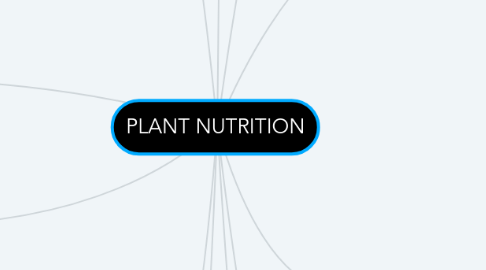
1. factors affect photosynthesis
1.1. concentration carbon dioxide
1.2. sunlight/light intensity
1.2.1. rate of photosynthesis is great
1.2.1.1. sugars formed faster than they can be removed
1.2.1.1.1. excess glucose converted to starch
1.2.2. at night, photosynthesis stops
1.2.2.1. starch converted by enzymes back into glucose
1.2.2.2. starch converted by enzymes back into glucose
1.3. suitable temperature
1.3.1. photosynthesis depends on enzyme reaction in chloroplasts
1.3.1.1. optimum temperature needed for enzymes to work well
1.4. water
1.5. chlorophyll
2. how plants absorb sunlight
2.1. chlorophyll
2.1.1. pigment in plants that absorbs sunlight
2.1.2. gives plant its green colour
3. glucose produced
3.1. what happens to glucose
3.1.1. broken down during respiration to release energy for vital activities
3.1.2. used in synthesis of cell wall
3.1.3. converted to amino acids and proteins
3.1.4. converted into fats
3.1.4.1. for storage
3.1.4.2. used in cellular respiration
3.1.4.3. for synthesis of new protoplasm
3.1.5. excess stored temporarily as starch in leaves
3.1.6. for cellular respiration to provided energy for cellular activities
3.1.7. converted to sucrose
3.1.7.1. transported to other parts of the plant or to storage organs
3.1.7.1.1. seeds
3.1.7.1.2. stem tubers
3.1.7.1.3. root tubers
3.1.7.2. might be converted back to glucose
3.1.8. reacts with nitrates and other mineral salts absorbed from the soil
3.1.8.1. to form
3.1.8.1.1. amino acids in leaves
4. how to show that photosynthesis has taken place?
4.1. presence of starch shows that photosynthesis has taken place
5. leaf adaptations for photosynthesis
5.1. petiole
5.1.1. holds leaf in position to absorb maximum light energy
5.2. thing broad lamina
5.2.1. provides short diffusion distance for gases
5.2.2. large surface area for maximum absorption of light
5.3. waxy cuticle on upper and lower epidermis
5.3.1. reduces water loss by evaporation through the leaf
5.3.2. transparent for light to enter the leaf
5.4. presence of stomata in epidermal layers
5.4.1. open when light present and allows carbon dioxide to diffuse in and oxygen to diffuse out of the leaf
5.5. interconnecting system of air spaces in the spongy mesophyll
5.5.1. allows rapid diffusion of carbon dioxide and oxygen into and out of mesophyll cells
6. definition: photosynthesis is the process in which light energy is absorbed by chlorophyll is transformed into chemical energy. the chemical energy is used to synthesise carbohydrates from water and carbon dioxide. water and carbon dioxide are the raw materials for photosynthesis. oxygen is released during the process.
7. importance of photosynthesis
7.1. provides food
7.2. maintains the balance of oxygen and carbon dioxide in the atmosphere
7.3. makes chemical energy available to animals and other organisms
7.4. energy is stored in fossil fuels
8. Photosynthesis
8.1. occurs in two stages & enzymes play a part in both
8.1.1. light-dependent stage
8.1.1.1. light energy is converted to chemical energy by chlorophyll
8.1.1.2. water is converted to hydrogen atoms and oxygen
8.1.1.3. light energy used to split water molecuels into oxygen and hydrogen atoms aka photolysis
8.1.2. light-independent stage
8.1.2.1. carbon dioxide is converted to glucose with chemical energy in the presence of water
8.1.2.1.1. hydrogen produced in photolysis used to reduce carbon dioxide to glucose
8.1.2.2. hydrogen from photolysis
8.1.2.2.1. reduces carbon dioxide to glucose
9. External features of a leaf
9.1. lamina
9.1.1. carbon dioxide can rapidly reach the inner cells of the leaf
9.1.2. consists of upper epidermis, palisade and spongy mesophyll, lower eppidermis and stomata
9.1.2.1. upper epidermis
9.1.2.1.1. few or no stomata and a protective cuticle that prevents excessive evaporation of water
9.1.2.2. lower epidermis
9.1.2.2.1. cuticle and many stomata -- each enclosed by two bean-shaped guard cells which control its size and hence the rate of diffusion of gases through it
9.1.2.3. palisade mesophyll
9.1.2.3.1. cells are closely packed and contain numerous chloroplasts
9.1.2.4. spongy mesophyll
9.1.2.4.1. cells are loosely packed with numerous intercellular spaces for diffusion of gases
9.1.2.4.2. cells contain chloroplasts
9.1.2.5. mesophyll has veins containing xylem and phloem which make up vascular bundle that transports materials in plants
9.2. network of veins
9.2.1. carry water and mineral salts to the cells in the lamina and carry manufcatured food from these cells to other parts of the plant
9.3. leaf arrangement
9.3.1. leaves grow in pairs or singly in an alternate arrangement
9.3.2. leaves wont block one another from sunlight and receive sufficient sunlight
9.4. petiole
9.4.1. holds lamina away from the stem so that it can obtain sufficient sunlight air
10. how do guard cells control the size of the stomata
10.1. in sunlight
10.1.1. guard cells photosynthesis and convert light to chemical energy
10.1.1.1. chemical energy used to pump potassium ions into guard cells from neighbouring epidermial cells
10.1.2. water potential of guard cells lowered
10.1.2.1. water from neighbouring epidermial cells enter guard cells via osmosis
10.1.2.1.1. increases turgidity of guard cells and makes them swell
10.1.3. guard cells have thicker wall on one side of the cell
10.1.3.1. causes swollen guard cells to become more curved and pull the stoma open
10.2. at night
10.2.1. potassium ions that accumulated in guard cells diffuse out
10.2.2. water potential in the guard cells increases
10.2.2.1. water leaves cells by osmosis
10.2.3. guard cells become flaccid and stoma closes
11. how do carbon dioxide and water enter through the leaf
11.1. surfaces of mesophyll cell covered by thin film of water
11.1.1. carbon dioxide can dissovle it
11.1.1.1. dissolved carbon dioxide diffuses into the cell
11.2. water and mineral salts move from cell to cell through the mesophyll after the veins
11.2.1. xylem and phloem make up vascular bundle
